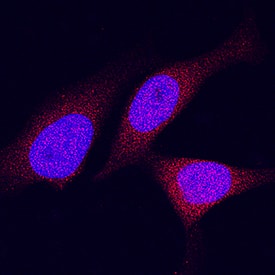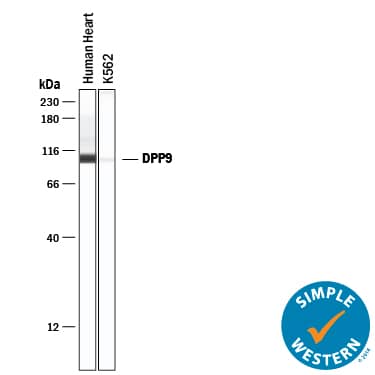Human DPP9 Antibody Summary
Arg2-Leu892
Accession # Q86TI2
Applications
Please Note: Optimal dilutions should be determined by each laboratory for each application. General Protocols are available in the Technical Information section on our website.
Scientific Data
 View Larger
View Larger
Detection of Human DPP9 by Western Blot. Western blot shows lysates of human heart tissue. PVDF membrane was probed with 1 µg/mL of Mouse Anti-Human DPP9 Monoclonal Antibody (Catalog # MAB54191) followed by HRP-conjugated Anti-Mouse IgG Secondary Antibody (Catalog # HAF018). A specific band was detected for DPP9 at approximately 100 kDa (as indicated). This experiment was conducted under reducing conditions and using Immunoblot Buffer Group 1.
 View Larger
View Larger
DPP9 in HeLa Human Cell Line. DPP9 was detected in immersion fixed HeLa human cervical epithelial carcinoma cell line using Mouse Anti-Human DPP9 Monoclonal Antibody (Catalog # MAB54191) at 8 µg/mL for 3 hours at room temperature. Cells were stained using the NorthernLights™ 557-conjugated Anti-Mouse IgG Secondary Antibody (red; Catalog # NL007) and counterstained with DAPI (blue). Specific staining was localized to cytoplasm and nuclei. View our protocol for Fluorescent ICC Staining of Cells on Coverslips.
 View Larger
View Larger
Detection of Human DPP9 by Simple WesternTM. Simple Western lane view shows lysates of human heart tissue and K562 human chronic myelogenous leukemia cell line, loaded at 0.2 mg/mL. A specific band was detected for DPP9 at approximately 104 kDa (as indicated) using 10 µg/mL of Mouse Anti-Human DPP9 Monoclonal Antibody (Catalog # MAB54191). This experiment was conducted under reducing conditions and using the 12-230 kDa separation system.
Reconstitution Calculator
Preparation and Storage
- 12 months from date of receipt, -20 to -70 °C as supplied.
- 1 month, 2 to 8 °C under sterile conditions after reconstitution.
- 6 months, -20 to -70 °C under sterile conditions after reconstitution.
Background: DPP9
DPP9 is a member of the S9b family of serine peptidases (1, 2). It shares 19% amino acid identity with DPP4 and 58% amino acid identity with DPP8. It exhibits post‑proline dipeptidyl aminopeptidase activity, cleaving Xaa-Pro dipeptides from the N-terminus of oligo- and polypeptides (3). Unlike DPP4, DPP9 does not appear to be membrane bound and is localized exclusively in the cytoplasm (4). This family of proline-specific dipeptidyl peptidases has been implicated in a variety of diseases including type 2 diabetes, obesity and cancer, and has been a potential target for drug discovery (5, 6).
- Olsen, C. and Wagtmann, N. (2002) Gene 299:185.
- Qi, S.Y. et al. (2003) Biochem. J. 373:179.
- Bjelke, J.R. et al. (2006) Biochem. J. 396:391.
- Ajami, K. et al. (2004) Biochim. Biophys. Acta. 1679:18.
- Rosenblum, J.S. and Kozarich, J.W. et al. (2003) Curr. Opin. Chem. Biol. 7:496.
- Van der Veken, P. et al. (2007) Curr. Top. Med. Chem. 7:621.
Product Datasheets
FAQs
No product specific FAQs exist for this product, however you may
View all Antibody FAQsReviews for Human DPP9 Antibody
There are currently no reviews for this product. Be the first to review Human DPP9 Antibody and earn rewards!
Have you used Human DPP9 Antibody?
Submit a review and receive an Amazon gift card.
$25/€18/£15/$25CAN/¥75 Yuan/¥2500 Yen for a review with an image
$10/€7/£6/$10 CAD/¥70 Yuan/¥1110 Yen for a review without an image

